PROJ6000: Project Management Report: Smartphone Software for Retail
VerifiedAdded on 2022/09/11
|11
|2351
|32
Report
AI Summary
This report, prepared for PROJ6000, provides a comprehensive overview of project management principles applied to the development of smartphone software for a retail organization. It begins by outlining the Project Management Body of Knowledge (PMBOK) areas, process groups, and their roles, emphasizing their importance in ensuring project viability. The report then delves into project selection methods, particularly cost-benefit analysis, and its application in determining the feasibility of the proposed software. The initiation process is examined, including the creation of a project charter, which defines project scope, objectives, and constraints. The report also details essential project documents, such as Gantt charts, feasibility studies, and resource allocation plans. Furthermore, it explores the application of project management tools, including risk assessment matrices and risk registers, to identify and manage potential risks. The report concludes by discussing the competencies necessary for project management success, including adaptability and employee empowerment, and provides a reference list and appendix with a Gantt chart. This report provides valuable insights into the practical application of project management principles in a real-world scenario.
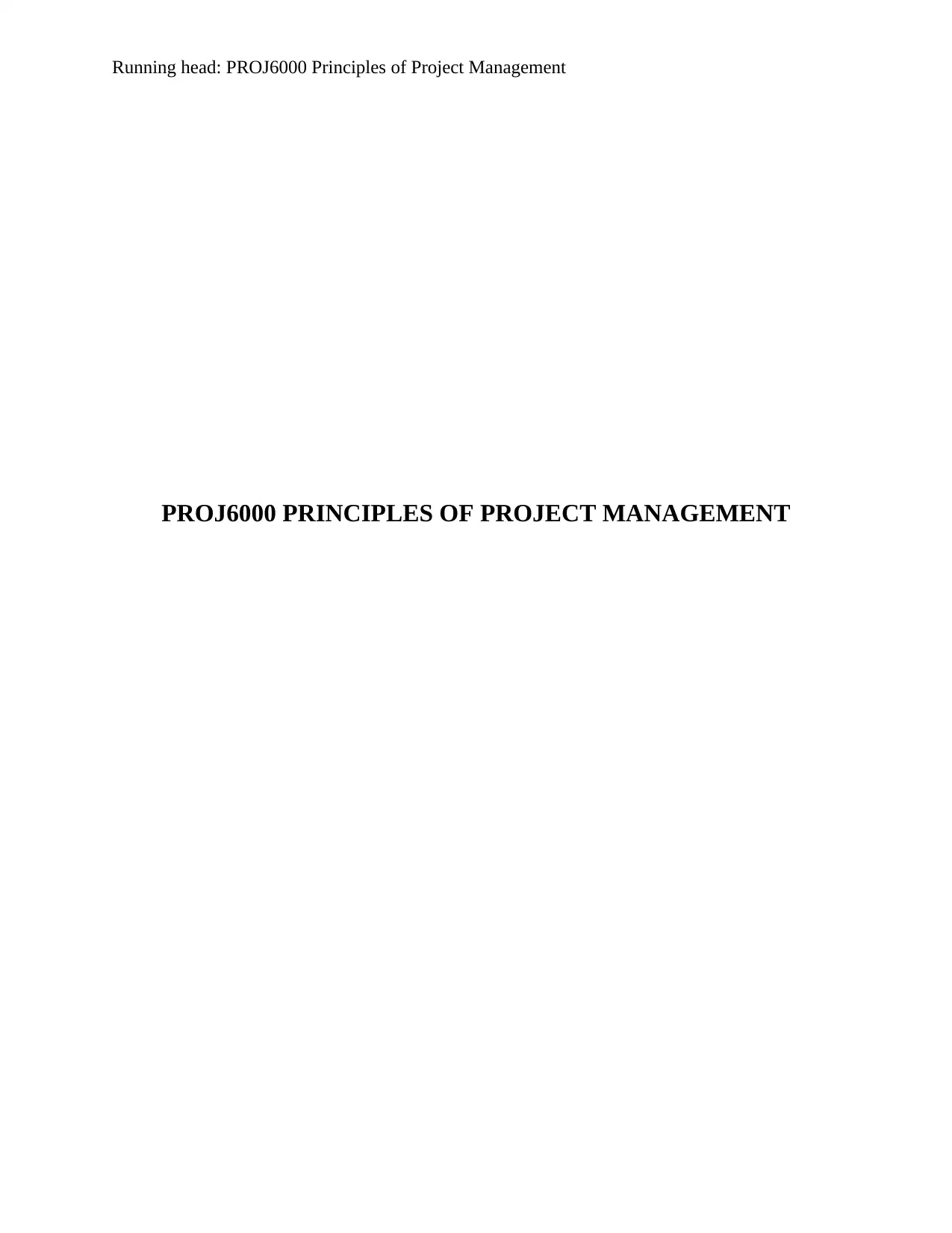
Running head: PROJ6000 Principles of Project Management
PROJ6000 PRINCIPLES OF PROJECT MANAGEMENT
PROJ6000 PRINCIPLES OF PROJECT MANAGEMENT
Paraphrase This Document
Need a fresh take? Get an instant paraphrase of this document with our AI Paraphraser
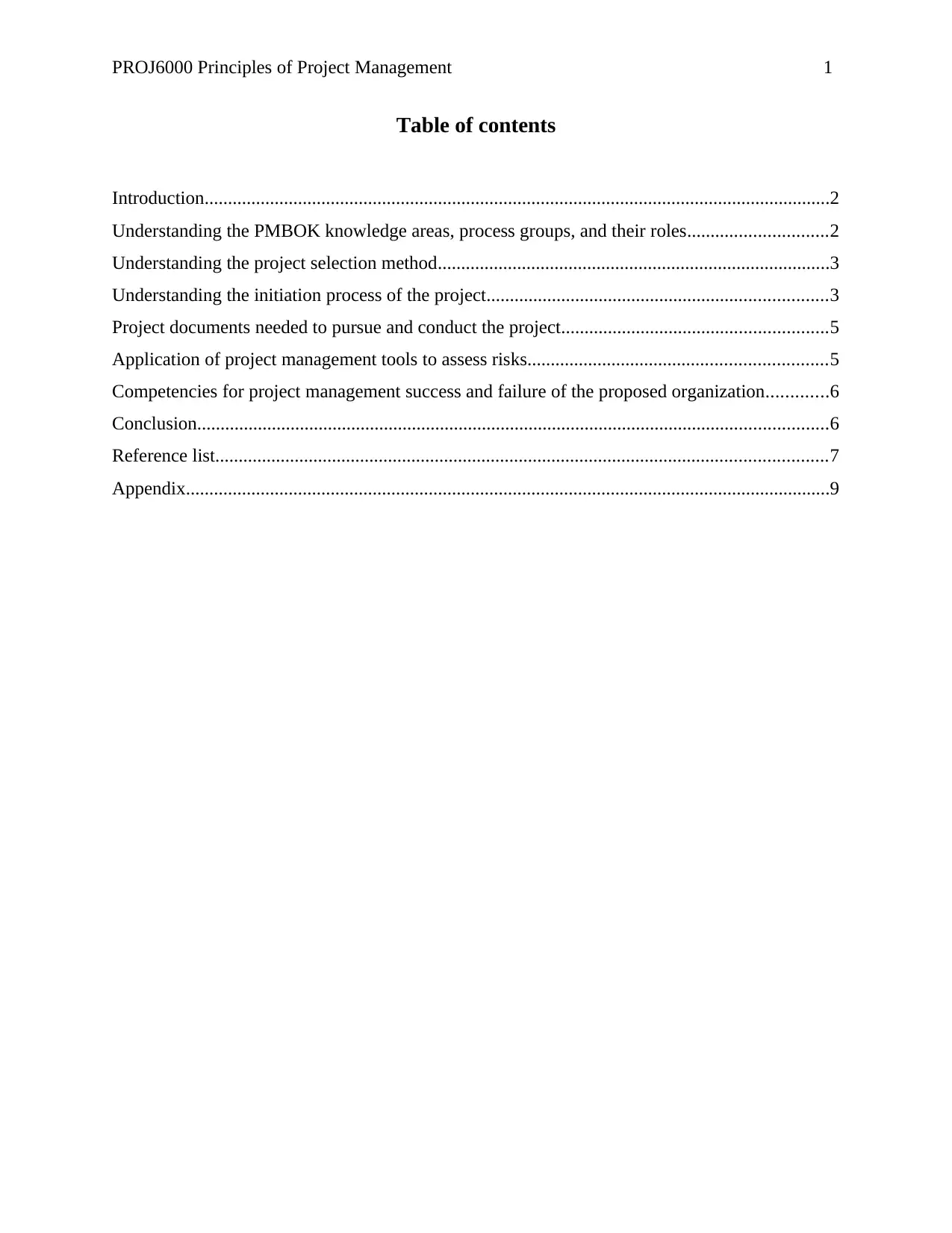
PROJ6000 Principles of Project Management 1
Table of contents
Introduction......................................................................................................................................2
Understanding the PMBOK knowledge areas, process groups, and their roles..............................2
Understanding the project selection method....................................................................................3
Understanding the initiation process of the project.........................................................................3
Project documents needed to pursue and conduct the project.........................................................5
Application of project management tools to assess risks................................................................5
Competencies for project management success and failure of the proposed organization.............6
Conclusion.......................................................................................................................................6
Reference list...................................................................................................................................7
Appendix..........................................................................................................................................9
Table of contents
Introduction......................................................................................................................................2
Understanding the PMBOK knowledge areas, process groups, and their roles..............................2
Understanding the project selection method....................................................................................3
Understanding the initiation process of the project.........................................................................3
Project documents needed to pursue and conduct the project.........................................................5
Application of project management tools to assess risks................................................................5
Competencies for project management success and failure of the proposed organization.............6
Conclusion.......................................................................................................................................6
Reference list...................................................................................................................................7
Appendix..........................................................................................................................................9
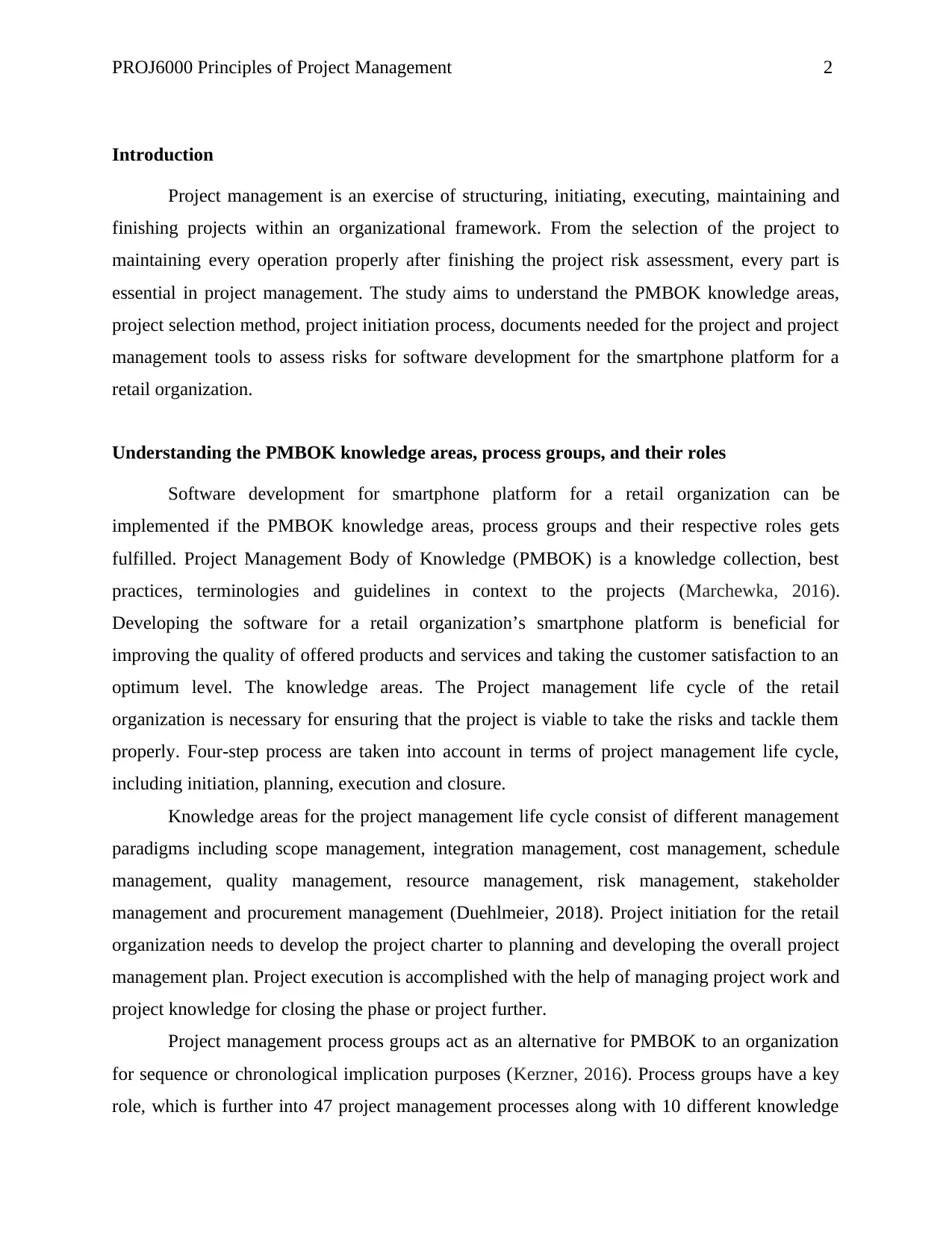
PROJ6000 Principles of Project Management 2
Introduction
Project management is an exercise of structuring, initiating, executing, maintaining and
finishing projects within an organizational framework. From the selection of the project to
maintaining every operation properly after finishing the project risk assessment, every part is
essential in project management. The study aims to understand the PMBOK knowledge areas,
project selection method, project initiation process, documents needed for the project and project
management tools to assess risks for software development for the smartphone platform for a
retail organization.
Understanding the PMBOK knowledge areas, process groups, and their roles
Software development for smartphone platform for a retail organization can be
implemented if the PMBOK knowledge areas, process groups and their respective roles gets
fulfilled. Project Management Body of Knowledge (PMBOK) is a knowledge collection, best
practices, terminologies and guidelines in context to the projects (Marchewka, 2016).
Developing the software for a retail organization’s smartphone platform is beneficial for
improving the quality of offered products and services and taking the customer satisfaction to an
optimum level. The knowledge areas. The Project management life cycle of the retail
organization is necessary for ensuring that the project is viable to take the risks and tackle them
properly. Four-step process are taken into account in terms of project management life cycle,
including initiation, planning, execution and closure.
Knowledge areas for the project management life cycle consist of different management
paradigms including scope management, integration management, cost management, schedule
management, quality management, resource management, risk management, stakeholder
management and procurement management (Duehlmeier, 2018). Project initiation for the retail
organization needs to develop the project charter to planning and developing the overall project
management plan. Project execution is accomplished with the help of managing project work and
project knowledge for closing the phase or project further.
Project management process groups act as an alternative for PMBOK to an organization
for sequence or chronological implication purposes (Kerzner, 2016). Process groups have a key
role, which is further into 47 project management processes along with 10 different knowledge
Introduction
Project management is an exercise of structuring, initiating, executing, maintaining and
finishing projects within an organizational framework. From the selection of the project to
maintaining every operation properly after finishing the project risk assessment, every part is
essential in project management. The study aims to understand the PMBOK knowledge areas,
project selection method, project initiation process, documents needed for the project and project
management tools to assess risks for software development for the smartphone platform for a
retail organization.
Understanding the PMBOK knowledge areas, process groups, and their roles
Software development for smartphone platform for a retail organization can be
implemented if the PMBOK knowledge areas, process groups and their respective roles gets
fulfilled. Project Management Body of Knowledge (PMBOK) is a knowledge collection, best
practices, terminologies and guidelines in context to the projects (Marchewka, 2016).
Developing the software for a retail organization’s smartphone platform is beneficial for
improving the quality of offered products and services and taking the customer satisfaction to an
optimum level. The knowledge areas. The Project management life cycle of the retail
organization is necessary for ensuring that the project is viable to take the risks and tackle them
properly. Four-step process are taken into account in terms of project management life cycle,
including initiation, planning, execution and closure.
Knowledge areas for the project management life cycle consist of different management
paradigms including scope management, integration management, cost management, schedule
management, quality management, resource management, risk management, stakeholder
management and procurement management (Duehlmeier, 2018). Project initiation for the retail
organization needs to develop the project charter to planning and developing the overall project
management plan. Project execution is accomplished with the help of managing project work and
project knowledge for closing the phase or project further.
Project management process groups act as an alternative for PMBOK to an organization
for sequence or chronological implication purposes (Kerzner, 2016). Process groups have a key
role, which is further into 47 project management processes along with 10 different knowledge
⊘ This is a preview!⊘
Do you want full access?
Subscribe today to unlock all pages.

Trusted by 1+ million students worldwide
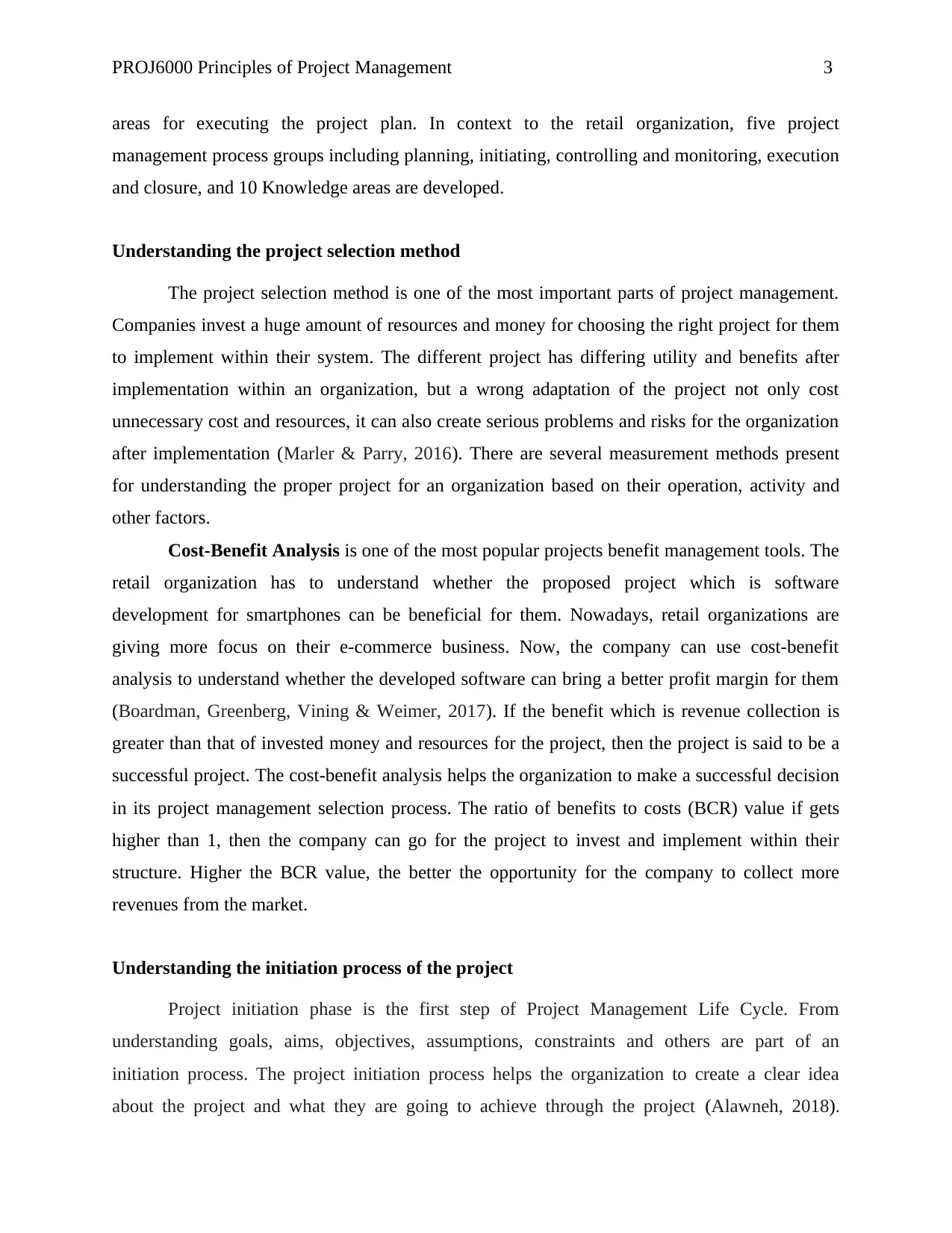
PROJ6000 Principles of Project Management 3
areas for executing the project plan. In context to the retail organization, five project
management process groups including planning, initiating, controlling and monitoring, execution
and closure, and 10 Knowledge areas are developed.
Understanding the project selection method
The project selection method is one of the most important parts of project management.
Companies invest a huge amount of resources and money for choosing the right project for them
to implement within their system. The different project has differing utility and benefits after
implementation within an organization, but a wrong adaptation of the project not only cost
unnecessary cost and resources, it can also create serious problems and risks for the organization
after implementation (Marler & Parry, 2016). There are several measurement methods present
for understanding the proper project for an organization based on their operation, activity and
other factors.
Cost-Benefit Analysis is one of the most popular projects benefit management tools. The
retail organization has to understand whether the proposed project which is software
development for smartphones can be beneficial for them. Nowadays, retail organizations are
giving more focus on their e-commerce business. Now, the company can use cost-benefit
analysis to understand whether the developed software can bring a better profit margin for them
(Boardman, Greenberg, Vining & Weimer, 2017). If the benefit which is revenue collection is
greater than that of invested money and resources for the project, then the project is said to be a
successful project. The cost-benefit analysis helps the organization to make a successful decision
in its project management selection process. The ratio of benefits to costs (BCR) value if gets
higher than 1, then the company can go for the project to invest and implement within their
structure. Higher the BCR value, the better the opportunity for the company to collect more
revenues from the market.
Understanding the initiation process of the project
Project initiation phase is the first step of Project Management Life Cycle. From
understanding goals, aims, objectives, assumptions, constraints and others are part of an
initiation process. The project initiation process helps the organization to create a clear idea
about the project and what they are going to achieve through the project (Alawneh, 2018).
areas for executing the project plan. In context to the retail organization, five project
management process groups including planning, initiating, controlling and monitoring, execution
and closure, and 10 Knowledge areas are developed.
Understanding the project selection method
The project selection method is one of the most important parts of project management.
Companies invest a huge amount of resources and money for choosing the right project for them
to implement within their system. The different project has differing utility and benefits after
implementation within an organization, but a wrong adaptation of the project not only cost
unnecessary cost and resources, it can also create serious problems and risks for the organization
after implementation (Marler & Parry, 2016). There are several measurement methods present
for understanding the proper project for an organization based on their operation, activity and
other factors.
Cost-Benefit Analysis is one of the most popular projects benefit management tools. The
retail organization has to understand whether the proposed project which is software
development for smartphones can be beneficial for them. Nowadays, retail organizations are
giving more focus on their e-commerce business. Now, the company can use cost-benefit
analysis to understand whether the developed software can bring a better profit margin for them
(Boardman, Greenberg, Vining & Weimer, 2017). If the benefit which is revenue collection is
greater than that of invested money and resources for the project, then the project is said to be a
successful project. The cost-benefit analysis helps the organization to make a successful decision
in its project management selection process. The ratio of benefits to costs (BCR) value if gets
higher than 1, then the company can go for the project to invest and implement within their
structure. Higher the BCR value, the better the opportunity for the company to collect more
revenues from the market.
Understanding the initiation process of the project
Project initiation phase is the first step of Project Management Life Cycle. From
understanding goals, aims, objectives, assumptions, constraints and others are part of an
initiation process. The project initiation process helps the organization to create a clear idea
about the project and what they are going to achieve through the project (Alawneh, 2018).
Paraphrase This Document
Need a fresh take? Get an instant paraphrase of this document with our AI Paraphraser
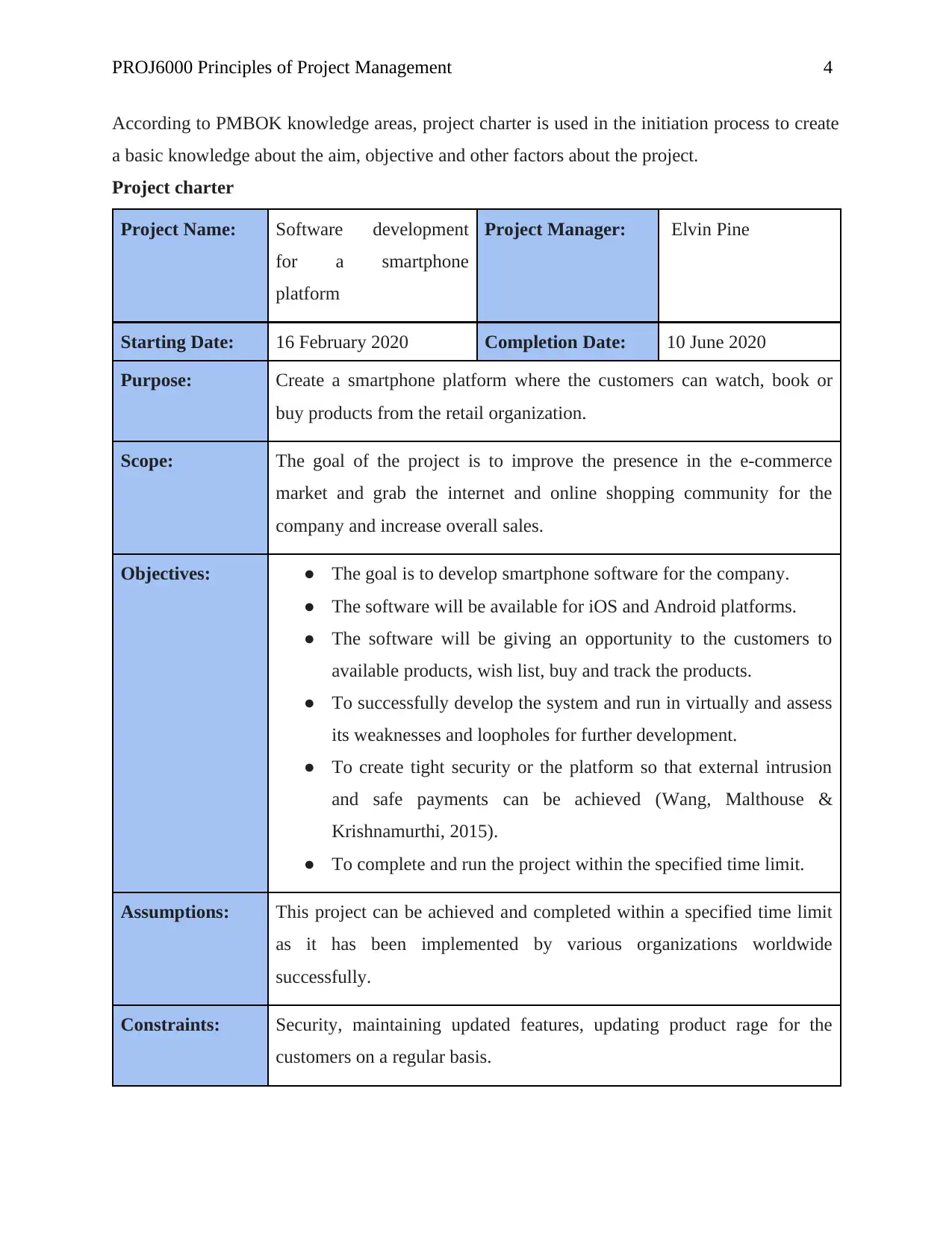
PROJ6000 Principles of Project Management 4
According to PMBOK knowledge areas, project charter is used in the initiation process to create
a basic knowledge about the aim, objective and other factors about the project.
Project charter
Project Name: Software development
for a smartphone
platform
Project Manager: Elvin Pine
Starting Date: 16 February 2020 Completion Date: 10 June 2020
Purpose: Create a smartphone platform where the customers can watch, book or
buy products from the retail organization.
Scope: The goal of the project is to improve the presence in the e-commerce
market and grab the internet and online shopping community for the
company and increase overall sales.
Objectives: ● The goal is to develop smartphone software for the company.
● The software will be available for iOS and Android platforms.
● The software will be giving an opportunity to the customers to
available products, wish list, buy and track the products.
● To successfully develop the system and run in virtually and assess
its weaknesses and loopholes for further development.
● To create tight security or the platform so that external intrusion
and safe payments can be achieved (Wang, Malthouse &
Krishnamurthi, 2015).
● To complete and run the project within the specified time limit.
Assumptions: This project can be achieved and completed within a specified time limit
as it has been implemented by various organizations worldwide
successfully.
Constraints: Security, maintaining updated features, updating product rage for the
customers on a regular basis.
According to PMBOK knowledge areas, project charter is used in the initiation process to create
a basic knowledge about the aim, objective and other factors about the project.
Project charter
Project Name: Software development
for a smartphone
platform
Project Manager: Elvin Pine
Starting Date: 16 February 2020 Completion Date: 10 June 2020
Purpose: Create a smartphone platform where the customers can watch, book or
buy products from the retail organization.
Scope: The goal of the project is to improve the presence in the e-commerce
market and grab the internet and online shopping community for the
company and increase overall sales.
Objectives: ● The goal is to develop smartphone software for the company.
● The software will be available for iOS and Android platforms.
● The software will be giving an opportunity to the customers to
available products, wish list, buy and track the products.
● To successfully develop the system and run in virtually and assess
its weaknesses and loopholes for further development.
● To create tight security or the platform so that external intrusion
and safe payments can be achieved (Wang, Malthouse &
Krishnamurthi, 2015).
● To complete and run the project within the specified time limit.
Assumptions: This project can be achieved and completed within a specified time limit
as it has been implemented by various organizations worldwide
successfully.
Constraints: Security, maintaining updated features, updating product rage for the
customers on a regular basis.
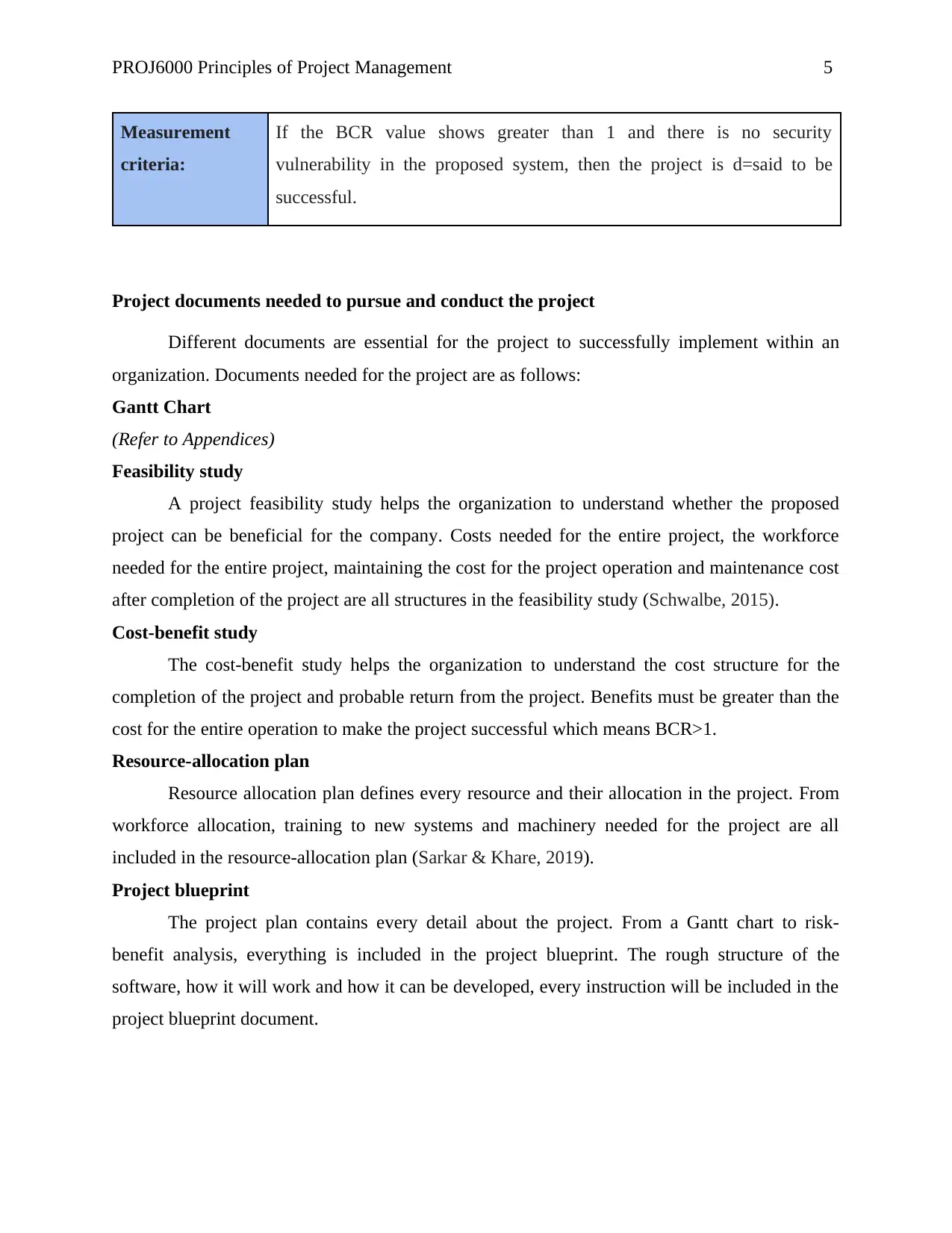
PROJ6000 Principles of Project Management 5
Measurement
criteria:
If the BCR value shows greater than 1 and there is no security
vulnerability in the proposed system, then the project is d=said to be
successful.
Project documents needed to pursue and conduct the project
Different documents are essential for the project to successfully implement within an
organization. Documents needed for the project are as follows:
Gantt Chart
(Refer to Appendices)
Feasibility study
A project feasibility study helps the organization to understand whether the proposed
project can be beneficial for the company. Costs needed for the entire project, the workforce
needed for the entire project, maintaining the cost for the project operation and maintenance cost
after completion of the project are all structures in the feasibility study (Schwalbe, 2015).
Cost-benefit study
The cost-benefit study helps the organization to understand the cost structure for the
completion of the project and probable return from the project. Benefits must be greater than the
cost for the entire operation to make the project successful which means BCR>1.
Resource-allocation plan
Resource allocation plan defines every resource and their allocation in the project. From
workforce allocation, training to new systems and machinery needed for the project are all
included in the resource-allocation plan (Sarkar & Khare, 2019).
Project blueprint
The project plan contains every detail about the project. From a Gantt chart to risk-
benefit analysis, everything is included in the project blueprint. The rough structure of the
software, how it will work and how it can be developed, every instruction will be included in the
project blueprint document.
Measurement
criteria:
If the BCR value shows greater than 1 and there is no security
vulnerability in the proposed system, then the project is d=said to be
successful.
Project documents needed to pursue and conduct the project
Different documents are essential for the project to successfully implement within an
organization. Documents needed for the project are as follows:
Gantt Chart
(Refer to Appendices)
Feasibility study
A project feasibility study helps the organization to understand whether the proposed
project can be beneficial for the company. Costs needed for the entire project, the workforce
needed for the entire project, maintaining the cost for the project operation and maintenance cost
after completion of the project are all structures in the feasibility study (Schwalbe, 2015).
Cost-benefit study
The cost-benefit study helps the organization to understand the cost structure for the
completion of the project and probable return from the project. Benefits must be greater than the
cost for the entire operation to make the project successful which means BCR>1.
Resource-allocation plan
Resource allocation plan defines every resource and their allocation in the project. From
workforce allocation, training to new systems and machinery needed for the project are all
included in the resource-allocation plan (Sarkar & Khare, 2019).
Project blueprint
The project plan contains every detail about the project. From a Gantt chart to risk-
benefit analysis, everything is included in the project blueprint. The rough structure of the
software, how it will work and how it can be developed, every instruction will be included in the
project blueprint document.
⊘ This is a preview!⊘
Do you want full access?
Subscribe today to unlock all pages.

Trusted by 1+ million students worldwide
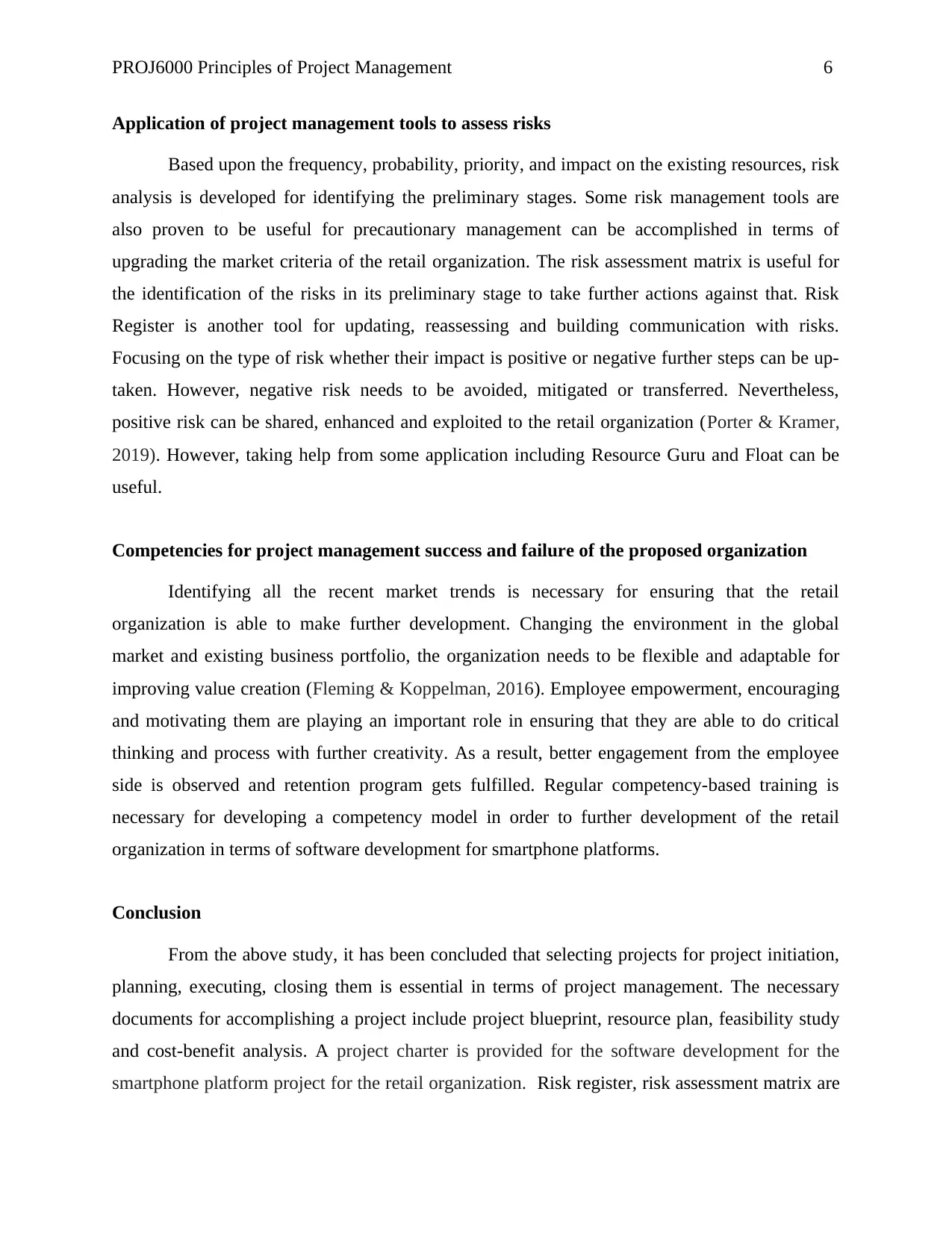
PROJ6000 Principles of Project Management 6
Application of project management tools to assess risks
Based upon the frequency, probability, priority, and impact on the existing resources, risk
analysis is developed for identifying the preliminary stages. Some risk management tools are
also proven to be useful for precautionary management can be accomplished in terms of
upgrading the market criteria of the retail organization. The risk assessment matrix is useful for
the identification of the risks in its preliminary stage to take further actions against that. Risk
Register is another tool for updating, reassessing and building communication with risks.
Focusing on the type of risk whether their impact is positive or negative further steps can be up-
taken. However, negative risk needs to be avoided, mitigated or transferred. Nevertheless,
positive risk can be shared, enhanced and exploited to the retail organization (Porter & Kramer,
2019). However, taking help from some application including Resource Guru and Float can be
useful.
Competencies for project management success and failure of the proposed organization
Identifying all the recent market trends is necessary for ensuring that the retail
organization is able to make further development. Changing the environment in the global
market and existing business portfolio, the organization needs to be flexible and adaptable for
improving value creation (Fleming & Koppelman, 2016). Employee empowerment, encouraging
and motivating them are playing an important role in ensuring that they are able to do critical
thinking and process with further creativity. As a result, better engagement from the employee
side is observed and retention program gets fulfilled. Regular competency-based training is
necessary for developing a competency model in order to further development of the retail
organization in terms of software development for smartphone platforms.
Conclusion
From the above study, it has been concluded that selecting projects for project initiation,
planning, executing, closing them is essential in terms of project management. The necessary
documents for accomplishing a project include project blueprint, resource plan, feasibility study
and cost-benefit analysis. A project charter is provided for the software development for the
smartphone platform project for the retail organization. Risk register, risk assessment matrix are
Application of project management tools to assess risks
Based upon the frequency, probability, priority, and impact on the existing resources, risk
analysis is developed for identifying the preliminary stages. Some risk management tools are
also proven to be useful for precautionary management can be accomplished in terms of
upgrading the market criteria of the retail organization. The risk assessment matrix is useful for
the identification of the risks in its preliminary stage to take further actions against that. Risk
Register is another tool for updating, reassessing and building communication with risks.
Focusing on the type of risk whether their impact is positive or negative further steps can be up-
taken. However, negative risk needs to be avoided, mitigated or transferred. Nevertheless,
positive risk can be shared, enhanced and exploited to the retail organization (Porter & Kramer,
2019). However, taking help from some application including Resource Guru and Float can be
useful.
Competencies for project management success and failure of the proposed organization
Identifying all the recent market trends is necessary for ensuring that the retail
organization is able to make further development. Changing the environment in the global
market and existing business portfolio, the organization needs to be flexible and adaptable for
improving value creation (Fleming & Koppelman, 2016). Employee empowerment, encouraging
and motivating them are playing an important role in ensuring that they are able to do critical
thinking and process with further creativity. As a result, better engagement from the employee
side is observed and retention program gets fulfilled. Regular competency-based training is
necessary for developing a competency model in order to further development of the retail
organization in terms of software development for smartphone platforms.
Conclusion
From the above study, it has been concluded that selecting projects for project initiation,
planning, executing, closing them is essential in terms of project management. The necessary
documents for accomplishing a project include project blueprint, resource plan, feasibility study
and cost-benefit analysis. A project charter is provided for the software development for the
smartphone platform project for the retail organization. Risk register, risk assessment matrix are
Paraphrase This Document
Need a fresh take? Get an instant paraphrase of this document with our AI Paraphraser

PROJ6000 Principles of Project Management 7
used for identifying the risk and managing them properly depending on the frequency,
probability, priority and impact on the existing resources. Regular competency-based training is
necessary for ensuring that the employees can do critical thinking and PMBOK knowledge areas
related to the existing business.
used for identifying the risk and managing them properly depending on the frequency,
probability, priority and impact on the existing resources. Regular competency-based training is
necessary for ensuring that the employees can do critical thinking and PMBOK knowledge areas
related to the existing business.
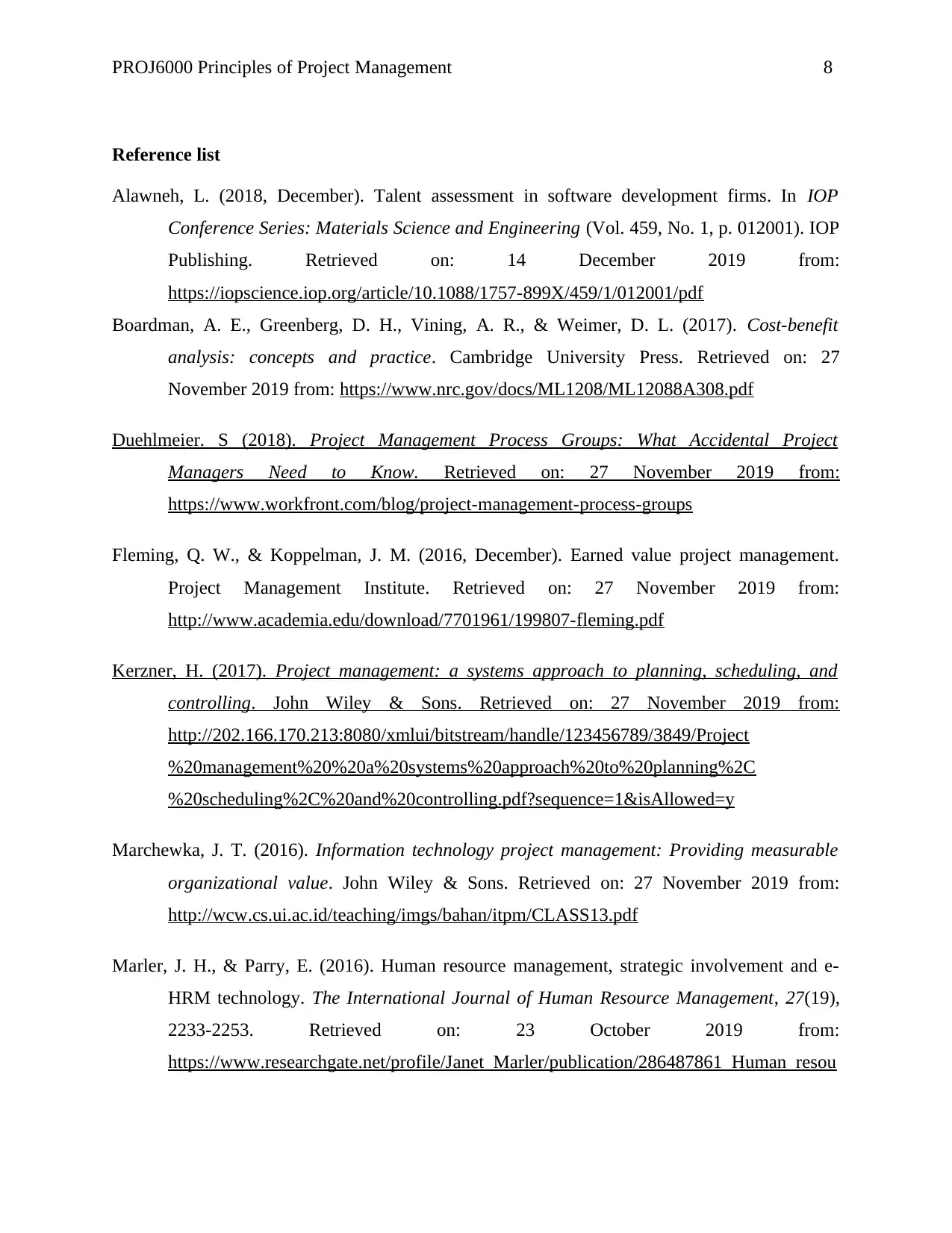
PROJ6000 Principles of Project Management 8
Reference list
Alawneh, L. (2018, December). Talent assessment in software development firms. In IOP
Conference Series: Materials Science and Engineering (Vol. 459, No. 1, p. 012001). IOP
Publishing. Retrieved on: 14 December 2019 from:
https://iopscience.iop.org/article/10.1088/1757-899X/459/1/012001/pdf
Boardman, A. E., Greenberg, D. H., Vining, A. R., & Weimer, D. L. (2017). Cost-benefit
analysis: concepts and practice. Cambridge University Press. Retrieved on: 27
November 2019 from: https://www.nrc.gov/docs/ML1208/ML12088A308.pdf
Duehlmeier. S (2018). Project Management Process Groups: What Accidental Project
Managers Need to Know. Retrieved on: 27 November 2019 from:
https://www.workfront.com/blog/project-management-process-groups
Fleming, Q. W., & Koppelman, J. M. (2016, December). Earned value project management.
Project Management Institute. Retrieved on: 27 November 2019 from:
http://www.academia.edu/download/7701961/199807-fleming.pdf
Kerzner, H. (2017). Project management: a systems approach to planning, scheduling, and
controlling. John Wiley & Sons. Retrieved on: 27 November 2019 from:
http://202.166.170.213:8080/xmlui/bitstream/handle/123456789/3849/Project
%20management%20%20a%20systems%20approach%20to%20planning%2C
%20scheduling%2C%20and%20controlling.pdf?sequence=1&isAllowed=y
Marchewka, J. T. (2016). Information technology project management: Providing measurable
organizational value. John Wiley & Sons. Retrieved on: 27 November 2019 from:
http://wcw.cs.ui.ac.id/teaching/imgs/bahan/itpm/CLASS13.pdf
Marler, J. H., & Parry, E. (2016). Human resource management, strategic involvement and e-
HRM technology. The International Journal of Human Resource Management, 27(19),
2233-2253. Retrieved on: 23 October 2019 from:
https://www.researchgate.net/profile/Janet_Marler/publication/286487861_Human_resou
Reference list
Alawneh, L. (2018, December). Talent assessment in software development firms. In IOP
Conference Series: Materials Science and Engineering (Vol. 459, No. 1, p. 012001). IOP
Publishing. Retrieved on: 14 December 2019 from:
https://iopscience.iop.org/article/10.1088/1757-899X/459/1/012001/pdf
Boardman, A. E., Greenberg, D. H., Vining, A. R., & Weimer, D. L. (2017). Cost-benefit
analysis: concepts and practice. Cambridge University Press. Retrieved on: 27
November 2019 from: https://www.nrc.gov/docs/ML1208/ML12088A308.pdf
Duehlmeier. S (2018). Project Management Process Groups: What Accidental Project
Managers Need to Know. Retrieved on: 27 November 2019 from:
https://www.workfront.com/blog/project-management-process-groups
Fleming, Q. W., & Koppelman, J. M. (2016, December). Earned value project management.
Project Management Institute. Retrieved on: 27 November 2019 from:
http://www.academia.edu/download/7701961/199807-fleming.pdf
Kerzner, H. (2017). Project management: a systems approach to planning, scheduling, and
controlling. John Wiley & Sons. Retrieved on: 27 November 2019 from:
http://202.166.170.213:8080/xmlui/bitstream/handle/123456789/3849/Project
%20management%20%20a%20systems%20approach%20to%20planning%2C
%20scheduling%2C%20and%20controlling.pdf?sequence=1&isAllowed=y
Marchewka, J. T. (2016). Information technology project management: Providing measurable
organizational value. John Wiley & Sons. Retrieved on: 27 November 2019 from:
http://wcw.cs.ui.ac.id/teaching/imgs/bahan/itpm/CLASS13.pdf
Marler, J. H., & Parry, E. (2016). Human resource management, strategic involvement and e-
HRM technology. The International Journal of Human Resource Management, 27(19),
2233-2253. Retrieved on: 23 October 2019 from:
https://www.researchgate.net/profile/Janet_Marler/publication/286487861_Human_resou
⊘ This is a preview!⊘
Do you want full access?
Subscribe today to unlock all pages.

Trusted by 1+ million students worldwide
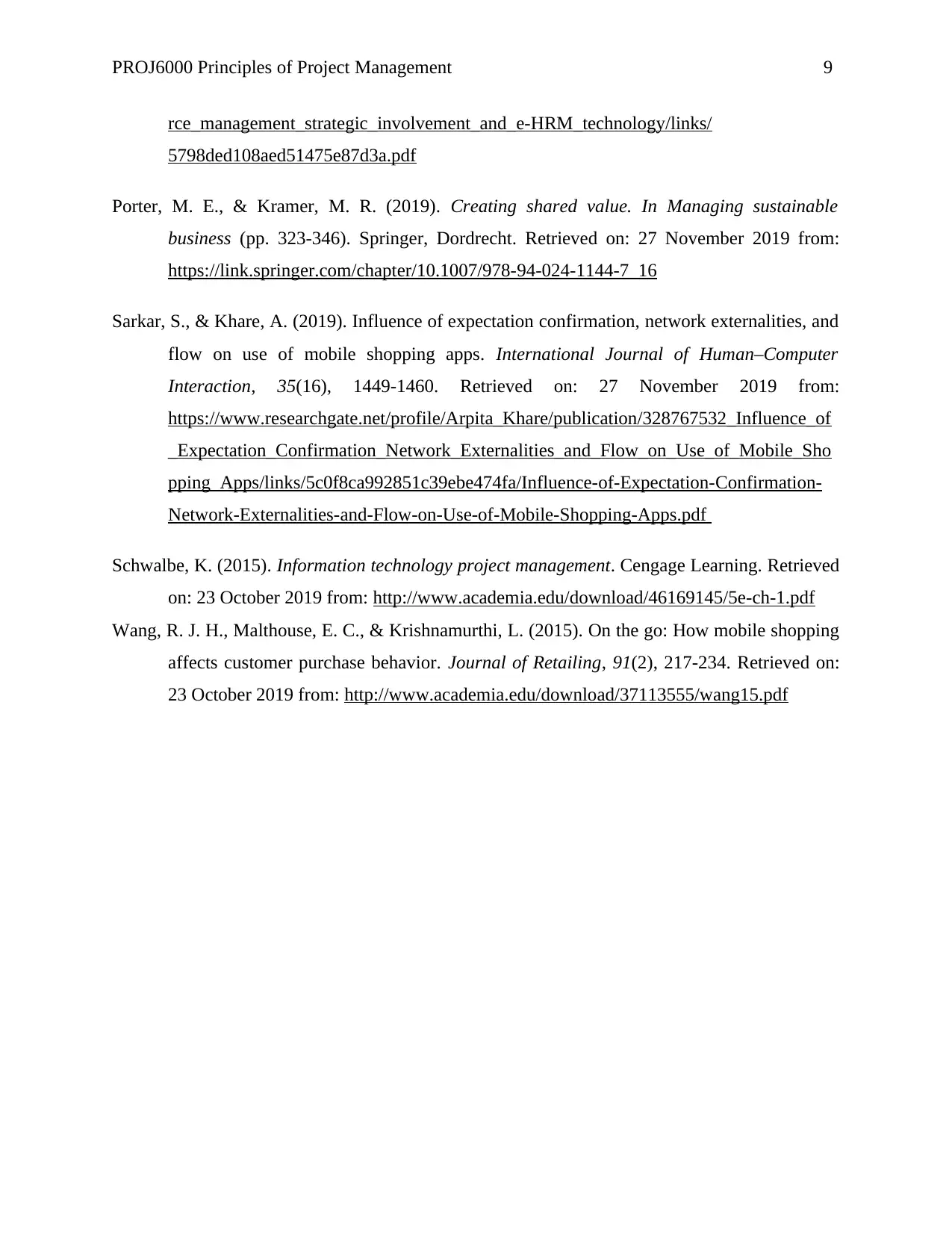
PROJ6000 Principles of Project Management 9
rce_management_strategic_involvement_and_e-HRM_technology/links/
5798ded108aed51475e87d3a.pdf
Porter, M. E., & Kramer, M. R. (2019). Creating shared value. In Managing sustainable
business (pp. 323-346). Springer, Dordrecht. Retrieved on: 27 November 2019 from:
https://link.springer.com/chapter/10.1007/978-94-024-1144-7_16
Sarkar, S., & Khare, A. (2019). Influence of expectation confirmation, network externalities, and
flow on use of mobile shopping apps. International Journal of Human–Computer
Interaction, 35(16), 1449-1460. Retrieved on: 27 November 2019 from:
https://www.researchgate.net/profile/Arpita_Khare/publication/328767532_Influence_of
_Expectation_Confirmation_Network_Externalities_and_Flow_on_Use_of_Mobile_Sho
pping_Apps/links/5c0f8ca992851c39ebe474fa/Influence-of-Expectation-Confirmation-
Network-Externalities-and-Flow-on-Use-of-Mobile-Shopping-Apps.pdf
Schwalbe, K. (2015). Information technology project management. Cengage Learning. Retrieved
on: 23 October 2019 from: http://www.academia.edu/download/46169145/5e-ch-1.pdf
Wang, R. J. H., Malthouse, E. C., & Krishnamurthi, L. (2015). On the go: How mobile shopping
affects customer purchase behavior. Journal of Retailing, 91(2), 217-234. Retrieved on:
23 October 2019 from: http://www.academia.edu/download/37113555/wang15.pdf
rce_management_strategic_involvement_and_e-HRM_technology/links/
5798ded108aed51475e87d3a.pdf
Porter, M. E., & Kramer, M. R. (2019). Creating shared value. In Managing sustainable
business (pp. 323-346). Springer, Dordrecht. Retrieved on: 27 November 2019 from:
https://link.springer.com/chapter/10.1007/978-94-024-1144-7_16
Sarkar, S., & Khare, A. (2019). Influence of expectation confirmation, network externalities, and
flow on use of mobile shopping apps. International Journal of Human–Computer
Interaction, 35(16), 1449-1460. Retrieved on: 27 November 2019 from:
https://www.researchgate.net/profile/Arpita_Khare/publication/328767532_Influence_of
_Expectation_Confirmation_Network_Externalities_and_Flow_on_Use_of_Mobile_Sho
pping_Apps/links/5c0f8ca992851c39ebe474fa/Influence-of-Expectation-Confirmation-
Network-Externalities-and-Flow-on-Use-of-Mobile-Shopping-Apps.pdf
Schwalbe, K. (2015). Information technology project management. Cengage Learning. Retrieved
on: 23 October 2019 from: http://www.academia.edu/download/46169145/5e-ch-1.pdf
Wang, R. J. H., Malthouse, E. C., & Krishnamurthi, L. (2015). On the go: How mobile shopping
affects customer purchase behavior. Journal of Retailing, 91(2), 217-234. Retrieved on:
23 October 2019 from: http://www.academia.edu/download/37113555/wang15.pdf
Paraphrase This Document
Need a fresh take? Get an instant paraphrase of this document with our AI Paraphraser
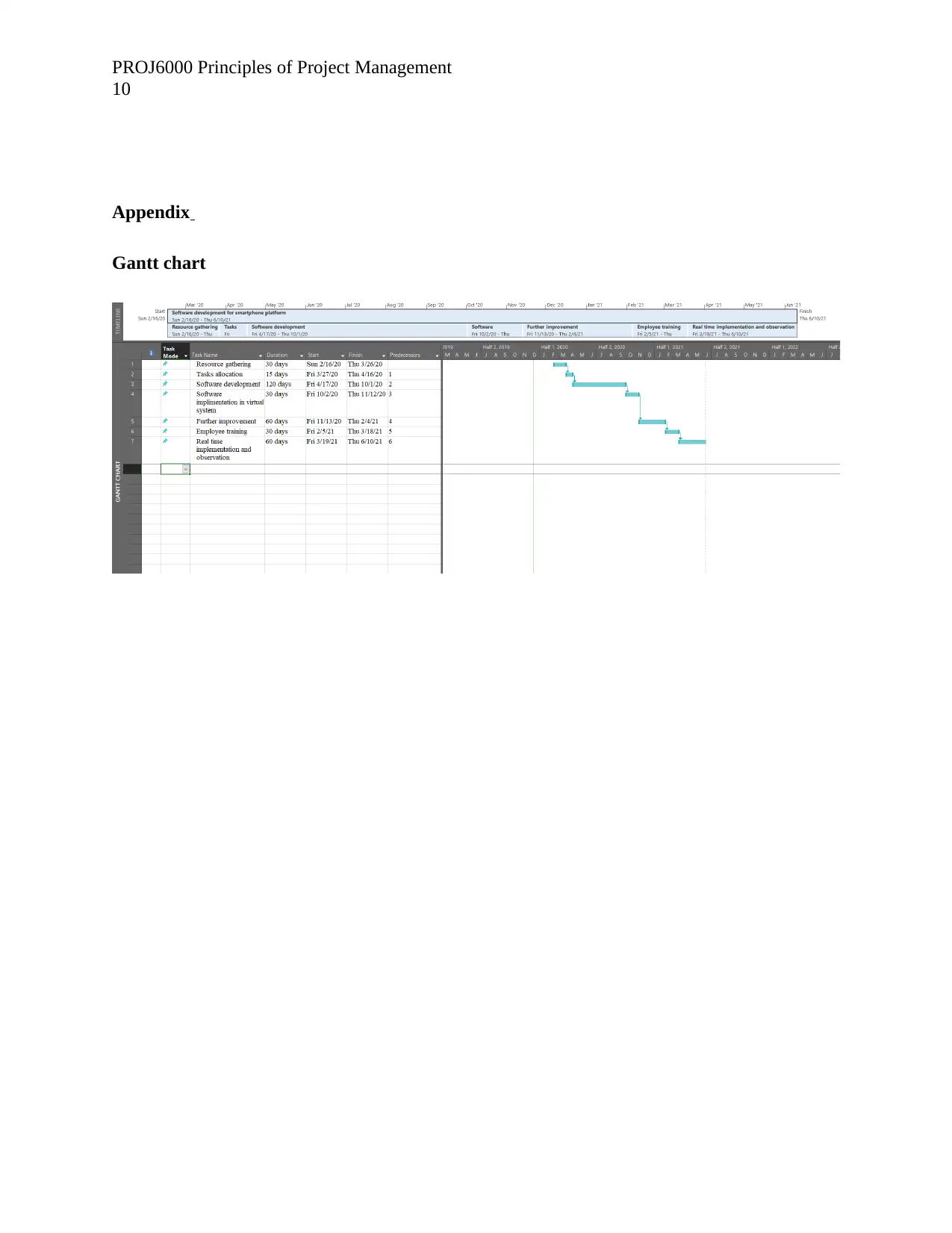
PROJ6000 Principles of Project Management
10
Appendix
Gantt chart
10
Appendix
Gantt chart
1 out of 11
Related Documents
Your All-in-One AI-Powered Toolkit for Academic Success.
+13062052269
info@desklib.com
Available 24*7 on WhatsApp / Email
![[object Object]](/_next/static/media/star-bottom.7253800d.svg)
Unlock your academic potential
Copyright © 2020–2025 A2Z Services. All Rights Reserved. Developed and managed by ZUCOL.



